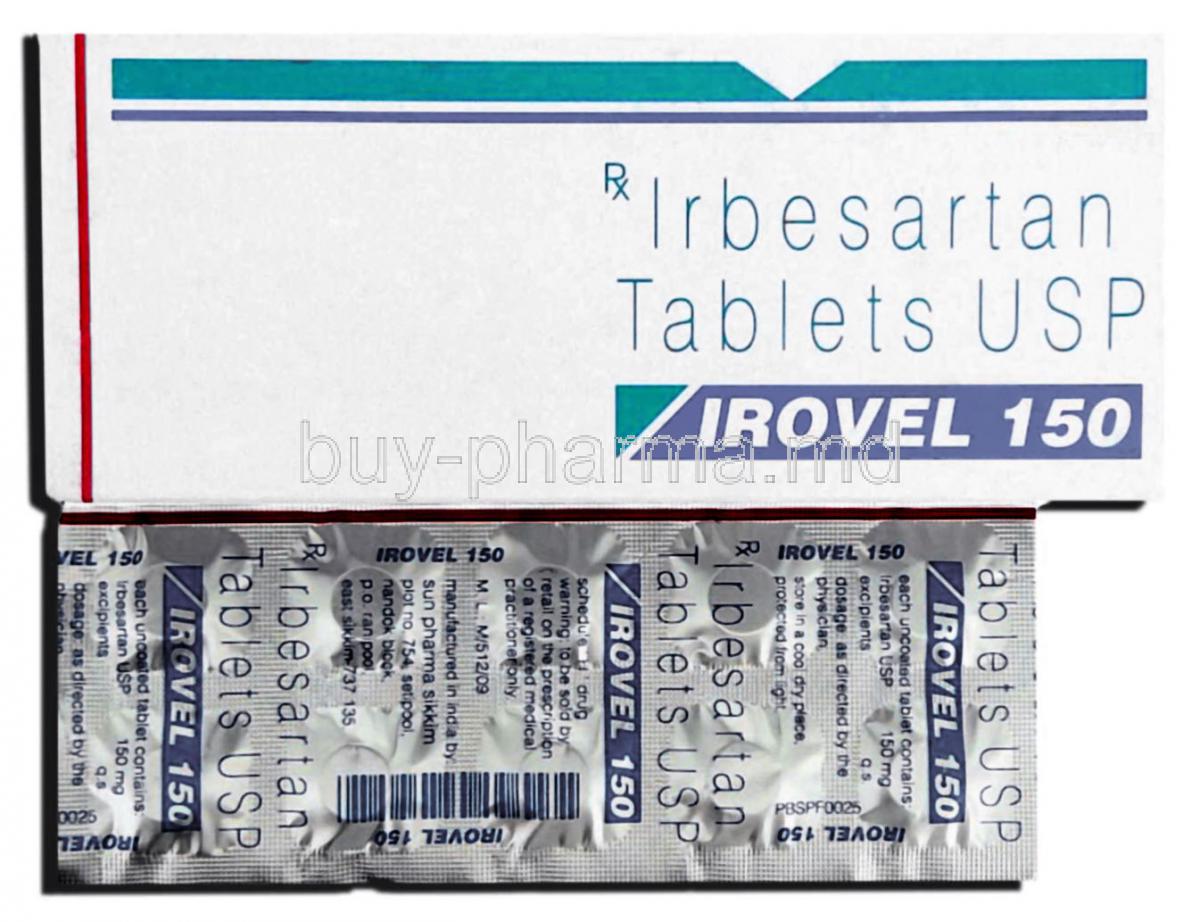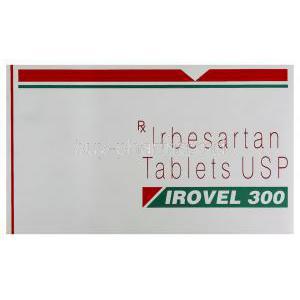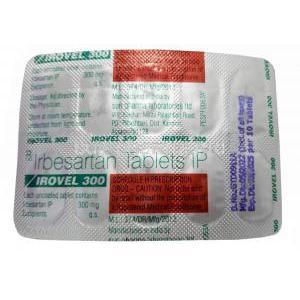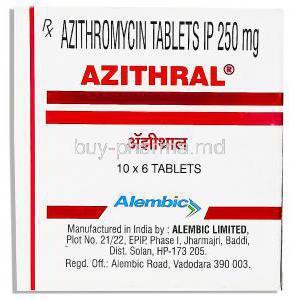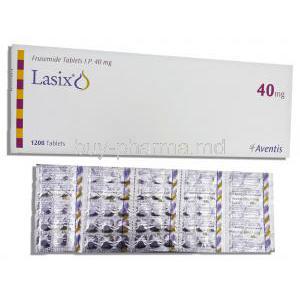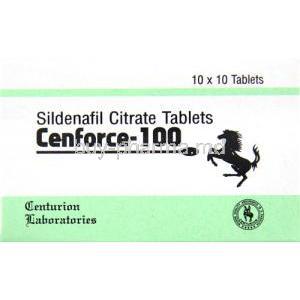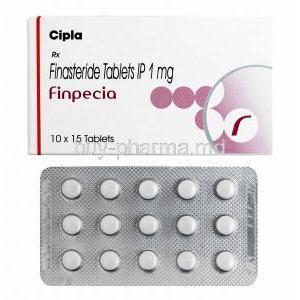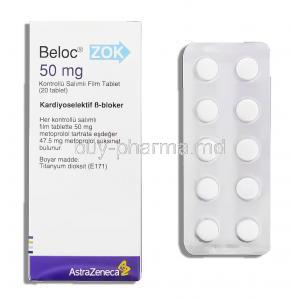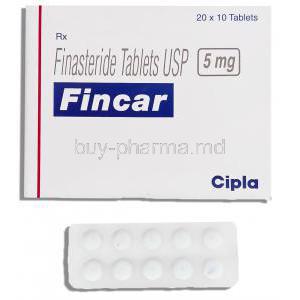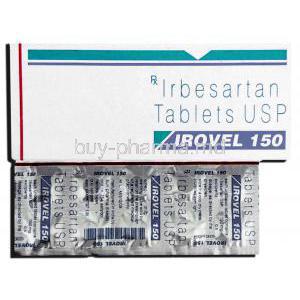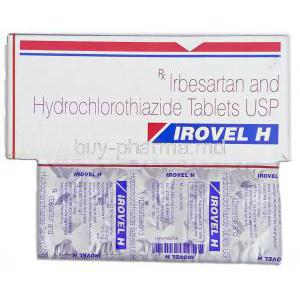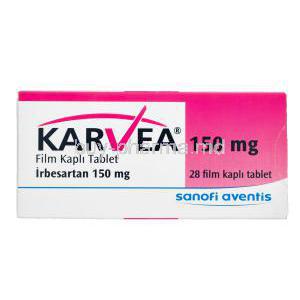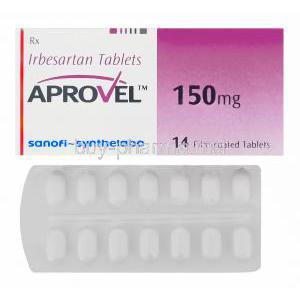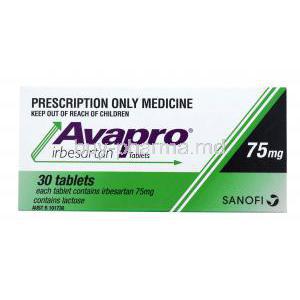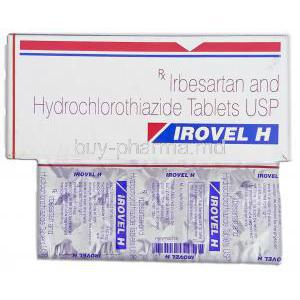Introduction
Irovel is a prescription medication that contains Irbesartan as its active ingredient. It belongs to the class of drugs known as Angiotensin II Receptor Blockers (ARBs), primarily prescribed for the management of hypertension and associated cardiovascular risks. By modulating the renin-angiotensin system, it provides both vascular protection and renal support, making it an essential therapy for patients with chronic cardiovascular or metabolic conditions.
Manufactured by reputable pharmaceutical companies, Irovel is distributed globally and recognized for its consistent quality and clinical efficacy. When compared to other ARBs such as Losartan, Valsartan, and Telmisartan, Irbesartan offers a longer duration of action and superior affinity for AT1 receptors, resulting in sustained blood pressure control. It has become a cornerstone in modern hypertension management and diabetic nephropathy prevention.
Composition and Formulation
- Active ingredient: Irbesartan
- Available strengths: 75 mg, 150 mg, and 300 mg tablets
- Excipients: Lactose monohydrate, microcrystalline cellulose, povidone, croscarmellose sodium, and magnesium stearate
- Form: Oral tablet
- Packaging: Typically supplied in blister packs to maintain stability and moisture resistance
Mechanism of Action – How Irovel Works
Angiotensin II, a potent vasoconstrictor, plays a central role in regulating blood pressure by constricting blood vessels and stimulating aldosterone secretion. Irovel works by selectively blocking the AT1 receptors, thereby preventing angiotensin II from binding and triggering these hypertensive effects.
As a result:
- Blood vessels remain relaxed and dilated
- Aldosterone secretion decreases, reducing sodium and water retention
- Blood pressure declines steadily and safely
Unlike ACE inhibitors, Irbesartan does not inhibit bradykinin breakdown, which minimizes the risk of persistent cough and angioedema. Over time, this mechanism provides cardiovascular and renal protection, reducing long-term complications in hypertensive and diabetic patients.
Clinical Uses and Therapeutic Indications
4.1 Primary Indications
- Treatment of essential hypertension to lower blood pressure and prevent vascular damage
- Management of diabetic nephropathy in patients with type 2 diabetes and hypertension
- Reduction of cardiovascular risk, including stroke, myocardial infarction, and heart failure
4.2 Off-Label Uses
- Heart Failure with Preserved Ejection Fraction (HFpEF): Helps reduce cardiac workload and prevent remodeling
- Diabetic Retinopathy Prevention: Slows microvascular complications in diabetic patients
- Left Ventricular Hypertrophy: Promotes regression of hypertrophy in long-standing hypertension
- Chronic Kidney Disease (CKD): Delays progression of non-diabetic renal impairment
- Resistant Hypertension: Used as adjunct therapy with diuretics or calcium channel blockers
Dosage and Administration
5.1 Standard Adult Dosage
The recommended starting dose for most adults is 150 mg once daily. Depending on therapeutic response, the dose may be increased to a maximum of 300 mg daily. Dose titration should be gradual to minimize hypotensive episodes.
5.2 Dosage in Special Conditions
- Renal impairment: Begin at a lower dose and monitor serum creatinine and potassium levels regularly.
- Hepatic impairment: Use cautiously; dosage adjustment may be required.
- Combination therapy: When co-administered with diuretics or beta-blockers, careful titration is recommended to avoid excessive hypotension.
5.3 Administration Guidelines
Irovel tablets are administered orally, with or without food. For optimal blood pressure regulation, take the medication at the same time each day. If a dose is missed, it should be taken as soon as remembered unless it is near the next scheduled dose—never double the dose.
Side Effects of Irovel
6.1 Common Side Effects
- Dizziness or lightheadedness
- Fatigue and mild weakness
- Headache and mild hypotension
- Gastrointestinal symptoms such as nausea or diarrhea
- Musculoskeletal discomfort or muscle cramps
6.2 Uncommon and Serious Side Effects
- Hyperkalemia: Elevated potassium levels requiring monitoring
- Renal impairment: Worsening kidney function in susceptible individuals
- Hypotension: Particularly in volume-depleted or diuretic-treated patients
- Hepatic enzyme elevation: Indicating potential liver stress
- Allergic reactions: Including rash, facial swelling, or angioedema
Drug Interactions
- Potassium supplements or potassium-sparing diuretics: Increased risk of hyperkalemia
- NSAIDs: May reduce antihypertensive effect and impair renal function
- Lithium and digoxin: Enhanced toxicity risk; monitor serum levels
- ACE inhibitors or aliskiren: Avoid combination in diabetic patients
- Alcohol and other antihypertensives: Additive hypotensive effects
Warnings and Important Precautions
- Monitor renal function and electrolytes periodically
- Risk of symptomatic hypotension in dehydrated or salt-depleted individuals
- Caution in heart failure or renal artery stenosis patients
- Contraindicated in pregnancy due to risk of fetal toxicity
- Regular follow-up for blood pressure and metabolic parameters is recommended
Contraindications
- Hypersensitivity to Irbesartan or any tablet component
- Pregnancy, especially during the second and third trimesters
- Severe hepatic impairment
- Bilateral renal artery stenosis
- Concomitant use with aliskiren in diabetic patients
Careful Administration and Patient Monitoring
- Initiate treatment cautiously in renal or hepatic dysfunction
- Monitor blood pressure and electrolytes during dose titration
- Conduct periodic kidney function tests in long-term therapy
- Adjust combination therapy with diuretics or beta-blockers based on clinical response
Continuous evaluation of treatment outcomes ensures safety, especially in elderly or multi-morbid patients requiring complex pharmacotherapy.
Special Population Considerations
11.1 Administration to Elderly Patients
Elderly patients often exhibit reduced renal clearance and physiological changes that alter drug metabolism. With Irovel, these factors heighten susceptibility to hypotension and renal impairment. Therefore, cautious initiation and individualized dose adjustments are imperative.
- Begin treatment with the lowest effective dose, typically 75 mg daily, and titrate slowly.
- Monitor renal function, serum potassium, and blood pressure frequently.
- Be alert for orthostatic hypotension, dizziness, or electrolyte disturbances.
Maintaining adequate hydration and avoiding excessive diuretic use can further minimize adverse reactions in this population.
11.2 Administration to Pregnant Women and Nursing Mothers
Irovel is strictly contraindicated during pregnancy due to its association with fetotoxicity, including fetal growth restriction, renal failure, and neonatal death. Angiotensin II receptor blockade during the second and third trimesters can severely compromise fetal renal function and amniotic fluid levels.
- Discontinue Irovel immediately upon detection of pregnancy.
- Substitute with antihypertensive agents proven safe during gestation, such as labetalol or methyldopa.
Irbesartan is also excreted in breast milk, posing potential risks to nursing infants. Lactating women should avoid Irovel or transition to an alternative medication compatible with breastfeeding.
11.3 Administration to Children
Data regarding pediatric safety and efficacy of Irovel remain limited. While some studies suggest potential use in hypertensive adolescents, standardized dosing parameters have not been firmly established. Therefore, the drug should be administered to children only under specialist supervision and with continuous monitoring of renal and cardiovascular function.
Overdosage and Management
Accidental or intentional overdose with Irovel can precipitate marked hypotension, dizziness, tachycardia, or reflex bradycardia. The primary concern in overdose is excessive vasodilation and circulatory collapse.
- Initiate supportive management and close hemodynamic monitoring.
- Administer intravenous fluids and electrolyte replacements as indicated.
- Activated charcoal may help reduce absorption if administered early.
Hemodialysis is unlikely to remove irbesartan effectively due to its high protein binding. Recovery generally occurs with appropriate supportive care and stabilization of cardiovascular function.
Storage and Handling Precautions
- Storage temperature: Store below 30°C (86°F) in a cool, dry environment.
- Humidity control: Avoid exposure to excessive moisture and direct sunlight.
- Packaging: Keep tablets in their original blister strips until use to ensure stability.
- Shelf life: Refer to the expiration date printed on the carton; expired medication should be discarded safely.
- Disposal: Follow local pharmaceutical waste guidelines; do not flush into drains or household trash.
Clinical Pharmacology
Absorption and Metabolism: Irbesartan exhibits high oral bioavailability (~60–80%), reaching peak plasma levels within 1.5–2 hours post-administration. It is metabolized primarily via the CYP2C9 hepatic enzyme pathway.
Distribution and Excretion: The drug is extensively protein-bound and eliminated through both biliary and renal routes, with a terminal half-life of approximately 11–15 hours. This allows for once-daily dosing.
Onset and Duration: Blood pressure reduction is noticeable within 2 weeks, with maximal effect achieved after 4–6 weeks of consistent therapy.
- Steady-state concentration reached in 3–5 days of continuous use.
- Food does not significantly affect absorption or bioavailability.
These pharmacokinetic attributes support stable, long-term antihypertensive efficacy and minimal dosing variability.
Patient Counseling Information
Effective management of hypertension requires consistent adherence and lifestyle modifications. Patients should be informed of the importance of taking Irovel exactly as prescribed to achieve optimal blood pressure control and renal protection.
- Adherence: Do not skip doses or discontinue abruptly without medical advice.
- Hydration: Maintain adequate fluid intake, especially during hot weather or illness.
- Avoid potassium supplements or salt substitutes unless prescribed by a physician.
- Report symptoms such as fainting, severe dizziness, or swelling immediately.
Regular monitoring of blood pressure, renal function, and electrolyte levels is essential to ensure safety and therapeutic success.
Frequently Asked Questions (FAQs)
How long does it take for Irovel to lower blood pressure?
Most patients experience a gradual reduction in blood pressure within 1–2 weeks, with full therapeutic benefits typically evident after 4–6 weeks of continuous treatment.
Can Irovel be taken at night?
Yes. Irovel can be taken either in the morning or at night, but consistency in timing helps maintain steady blood pressure control.
Is Irovel safe for diabetic patients?
Yes. In fact, Irovel provides additional renal protection for diabetic patients, particularly those with proteinuria or early nephropathy.
Can I take Irovel with alcohol or painkillers?
Alcohol may enhance the blood pressure-lowering effect and increase dizziness. NSAID painkillers, such as ibuprofen, can reduce Irovel’s efficacy and strain kidney function. Consult a doctor before combining them.
What should I do if I miss a dose?
If you miss a dose, take it as soon as you remember. If it is close to your next dose, skip the missed one and resume your regular schedule. Never double up to compensate for a missed dose.
Is Irovel habit-forming or addictive?
No. Irovel is not habit-forming and carries no risk of dependency or withdrawal symptoms.
Summary and Key Takeaways
Irovel (Irbesartan) stands as a well-tolerated, effective antihypertensive medication that safeguards both the heart and kidneys. Its targeted mechanism of angiotensin II receptor blockade ensures stable blood pressure regulation with minimal side effects.
- Demonstrates high efficacy in long-term cardiovascular and renal protection.
- Suitable for patients intolerant to ACE inhibitors due to its bradykinin-independent mechanism.
- Comparable or superior therapeutic outcomes to other ARBs like Losartan and Valsartan.
- Regular medical supervision and adherence amplify treatment success.
By integrating pharmacologic therapy with lifestyle adjustments, Irovel contributes significantly to the prevention of cardiovascular events and the preservation of renal function in hypertensive individuals.

